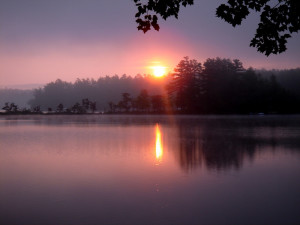Maine Lakefront Property Owners Prevent Invasive Aquatic Plants With Eyes on the Water
Out and About for the Sebago Lakes Region of Maine July 17-23
July 17, 2014Upta Camp Style Property For Sale Near Lake Annabessacook, Monmouth, Maine
July 20, 2014Maine Lakefront Property Owners Prevent Invasive Aquatic Plants With Eyes on the Water
Kezar Lake, Lovell, Maine — A Special Place
by Leigh Macmillen Hayes
“Milfoil ↑! Property Value$$$ ↓” So proclaims the sign for lakefront property owners to notice on the roads surrounding Moose Pond in Bridgton, Maine. Fortunately, there are no invasive aquatic plants in Moose Pond at this time, but diligence is necessary. Courtesy Boat Inspectors (CBI) man the two boat ramps and signs encourage people to inspect their boats, motors, trailers and fishing gear when no CBI inspectors are present.
To that end, in nearby Lovell, the town has taken a proactive approach to invasive plant prevention. More than ten years ago, the town decided to raise awareness of the new State law concerning Invasive Aquatic Plants (IAPs). They formed the Lovell Invasive Plant Prevention Committee, which they refer to as LIPPC.
Because there was an infestation of variable-leaf milfoil in Cushman Pond (hand removal by trained divers and benthic barriers to prevent further growth have kept the problem at Cushman to a bare minimum), residents were concerned about the possibility of it spreading downstream to Heald Pond and Kezar Lake.
What’s a small town to do? Jump on the bandwagon and engage the help of year-round and seasonal residents.
Educating the public is one of the ways to prevent the introduction or spread of invasive aquatic species into the watershed. (Remember, it’s not just plants that are invasive. Think zebra muscles and Chinese snails, etc.)
Each summer, LIPPC hosts “Eyes on the Water” plant paddles two or three times. These are introductory outings aimed at familiarizing the public with native and non-native aquatic plants. The committee developed a booklet with illustrations to help in identification. These are fun sessions where participants receive some instruction on how to use a Quick Key and several other resources, then head onto the water in kayaks and canoes to examine plants and bring back samples for verification. With the support of VLMP, this activity has been occurring for several years.
LIPPC’s latest detection activities include two new programs.
Like neighborhood crime watches intended to keep intruders at bay, over forty stewards are now keeping a watchful eye on the shoreline of Kezar Lake and the ponds in Lovell. Their task is to look for any evidence of plants or activities that may introduce them. As stewards, they receive training, check the shoreline periodically and report any sightings, issues or concerns.
Another new program is the Invasive Plant Patrol. This group of volunteers completes IAP training with the VLMP. They continue their training with practice sessions on the water, and will ultimately conduct plant surveys in the littoral zone (the zone where the light reaches the bottom) on the lake and all of the ponds.
Any sightings of aquatic invasives are reported to the Maine DEP and VLMP for verification (and eradication if necessary).
It’s programs like these that many lake associations around Maine have or are in the process of implementing. Residents are given the tools to feel empowered about protecting the watershed that they love.
The Panther Pond Association in Raymond developed an IAP program twelve years ago and were instrumental in helping LIPPC with the process. As they say, the more “eyes on the water,” the better.
To learn more about lakefront properties for sale on Kezar Lake in Lovell, click on the green box above.
To learn more about the Lovell area, check out the blog links below.
Ebenezer’s Pub in Lovell, Maine – Where Kezar Lakers Go For Beer and Hospitality
Lake Kezar Country Club a Gem of a Golf Club Next to Kezar Lake in Lovell, Maine


